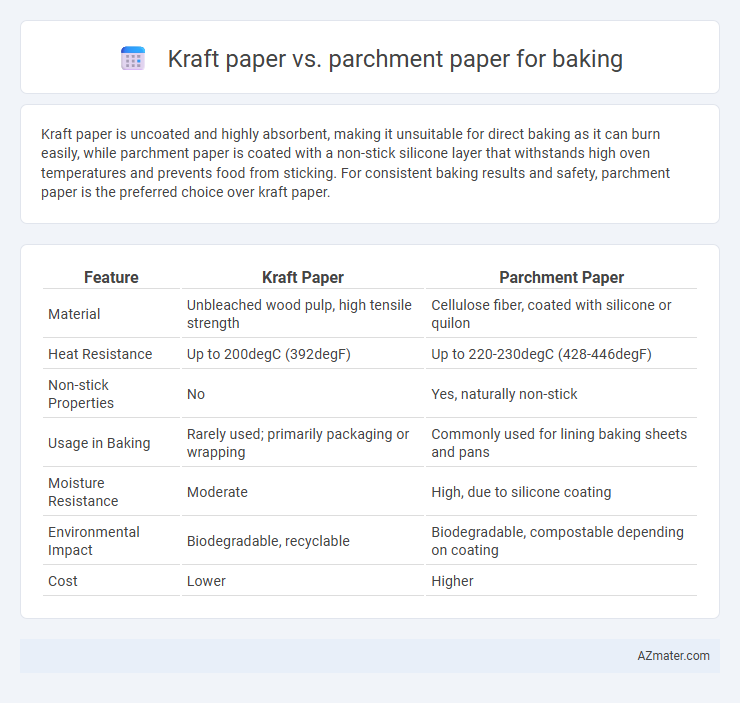Kraft paper is uncoated and highly absorbent, making it unsuitable for direct baking as it can burn easily, while parchment paper is coated with a non-stick silicone layer that withstands high oven temperatures and prevents food from sticking. For consistent baking results and safety, parchment paper is the preferred choice over kraft paper.
Table of Comparison
| Feature | Kraft Paper | Parchment Paper |
|---|---|---|
| Material | Unbleached wood pulp, high tensile strength | Cellulose fiber, coated with silicone or quilon |
| Heat Resistance | Up to 200degC (392degF) | Up to 220-230degC (428-446degF) |
| Non-stick Properties | No | Yes, naturally non-stick |
| Usage in Baking | Rarely used; primarily packaging or wrapping | Commonly used for lining baking sheets and pans |
| Moisture Resistance | Moderate | High, due to silicone coating |
| Environmental Impact | Biodegradable, recyclable | Biodegradable, compostable depending on coating |
| Cost | Lower | Higher |
Introduction to Kraft Paper and Parchment Paper
Kraft paper is a durable, unbleached paper made from wood pulp, commonly used for wrapping and packaging due to its strength and eco-friendly properties. Parchment paper, coated with silicone, provides a non-stick, heat-resistant surface ideal for baking and cooking, preventing food from sticking and promoting even heat distribution. Both papers serve distinct purposes in the kitchen, with kraft paper offering structural support and parchment paper enhancing baking efficiency.
Composition and Manufacturing Differences
Kraft paper is made from wood pulp via the Kraft process, resulting in a strong, coarse-textured, unbleached paper primarily consisting of cellulose fibers. Parchment paper undergoes a sulfuring or siliconizing treatment, creating a non-stick, heat-resistant surface ideal for baking by chemically altering its cellulose to withstand high oven temperatures. The manufacturing differences lead to Kraft paper being more porous and less heat tolerant, whereas parchment paper's coating provides moisture resistance and prevents food from sticking during baking.
Heat Resistance and Oven Safety
Kraft paper has limited heat resistance, typically withstanding temperatures up to 250degF (121degC), making it unsuitable for most baking applications as it can char or ignite at higher oven temperatures. Parchment paper is specifically designed for baking, offering heat resistance up to 420degF (215degC) or higher, ensuring oven safety without burning or releasing harmful fumes. Using parchment paper in baking provides a non-stick, heat-safe barrier, while kraft paper is better suited for packaging rather than direct oven use.
Non-Stick Properties Compared
Parchment paper offers superior non-stick properties for baking due to its silicone coating, which prevents food from adhering and ensures easy release of baked goods. Kraft paper lacks this silicone treatment, making it prone to sticking and less suitable for delicate items or high-moisture recipes. For optimal non-stick performance and easy cleanup, parchment paper is the preferred choice in baking applications.
Grease and Moisture Resistance
Kraft paper has moderate grease resistance but is less effective at preventing moisture penetration compared to parchment paper, which features a silicone coating that provides superior grease and moisture resistance essential for baking. Parchment paper's non-stick surface prevents baked goods from absorbing excess grease, ensuring crisp textures and easy cleanup. In contrast, kraft paper may absorb oils and moisture, potentially compromising the texture and structural integrity of baked items.
Environmental Impact and Sustainability
Kraft paper is typically unbleached and biodegradable, making it a more environmentally friendly option compared to parchment paper, which often contains silicone coatings that hinder compostability. The production of kraft paper uses fewer chemicals and results in less pollution, enhancing its sustainability profile for baking purposes. Choosing kraft paper reduces landfill waste and supports eco-conscious baking practices by minimizing synthetic material usage.
Typical Baking Uses for Kraft Paper
Kraft paper is commonly used for wrapping baked goods, lining baking trays, and protecting surfaces during baking due to its strength and heat resistance. Unlike parchment paper, which is non-stick and ideal for direct contact with food during baking, kraft paper generally requires a coating or additional treatment to prevent sticking. Its primary role in typical baking applications includes packaging bread, cookies, and pastries for transport and storage rather than direct oven use.
Typical Baking Uses for Parchment Paper
Parchment paper is commonly used for baking tasks such as lining cookie sheets, cake pans, and roasting trays due to its non-stick and heat-resistant properties, which prevent sticking and promote even cooking. It is ideal for delicate baked goods like cookies, macarons, and cakes, as it provides a smooth surface that aids in effortless release. Unlike Kraft paper, parchment paper withstands high oven temperatures up to 420degF (215degC) without burning or affecting food quality, making it essential for reliable baking results.
Price Comparison and Availability
Kraft paper is generally more affordable than parchment paper, making it a cost-effective option for bulk baking and wrapping needs. Parchment paper, though pricier, offers superior non-stick properties and heat resistance, which justifies the higher cost for many bakers. Both are widely available online and in stores, but kraft paper tends to be easier to find in larger quantities and at lower prices.
Choosing the Right Paper for Your Baking Needs
Kraft paper, known for its strength and durability, is ideal for wrapping baked goods and providing sturdy, moisture-resistant packaging but is not heat-resistant and should not be used directly in the oven. Parchment paper, coated with silicone, offers excellent non-stick properties and withstands oven temperatures up to 450degF (232degC), making it perfect for lining baking sheets and preventing sticking or burning. Choosing the right paper depends on whether you need heat resistance and non-stick qualities for baking (parchment) or durable, greaseproof wrapping for storage and presentation (kraft).

Infographic: Kraft paper vs Parchment paper for Baking
 azmater.com
azmater.com